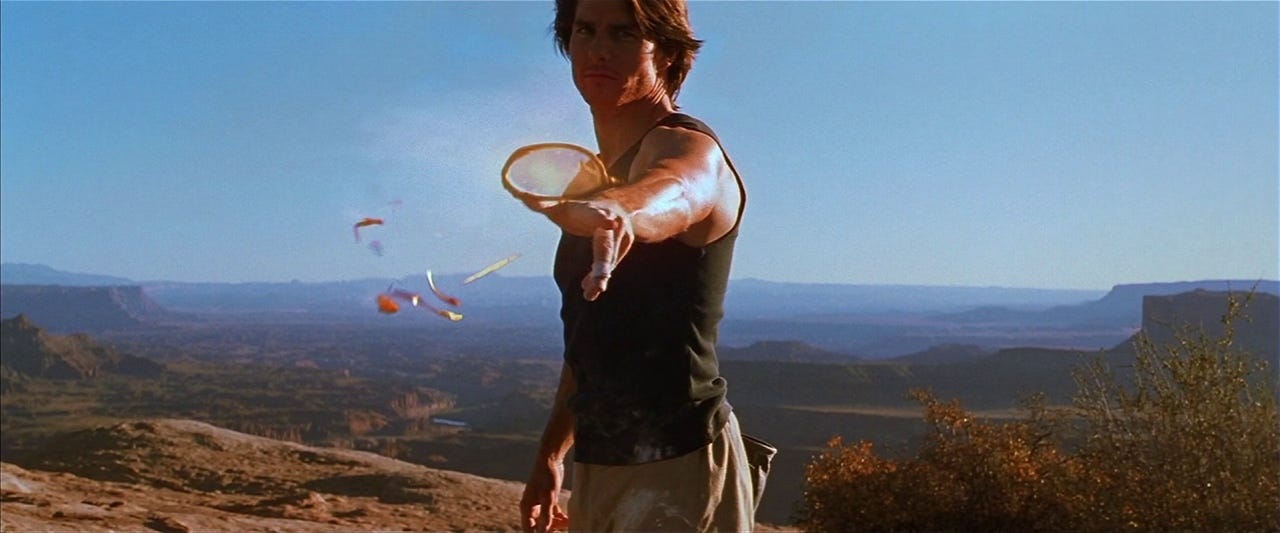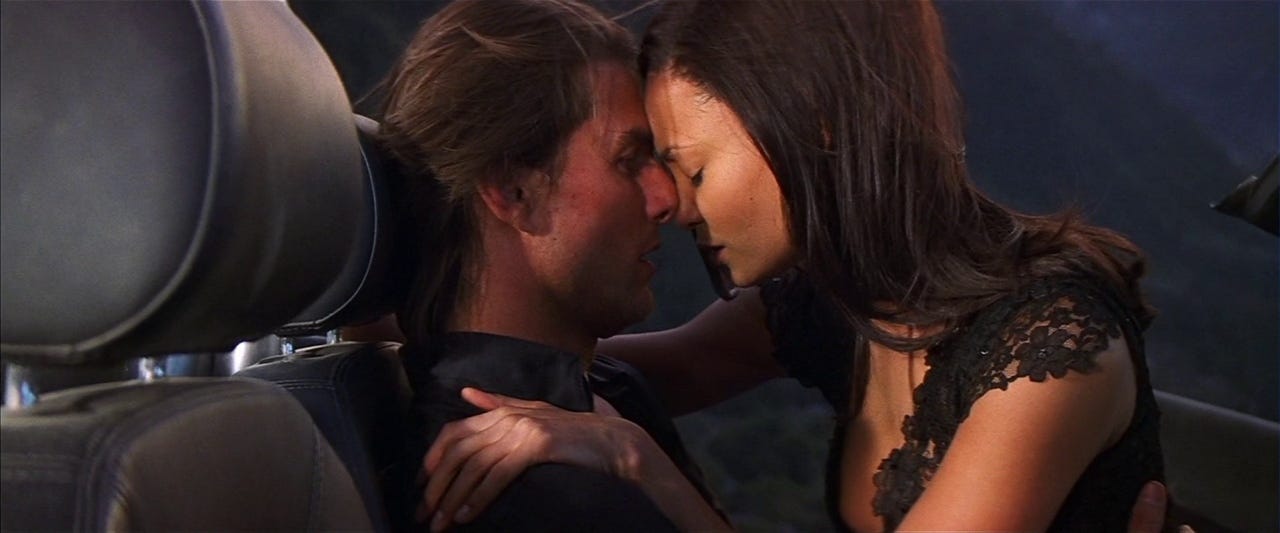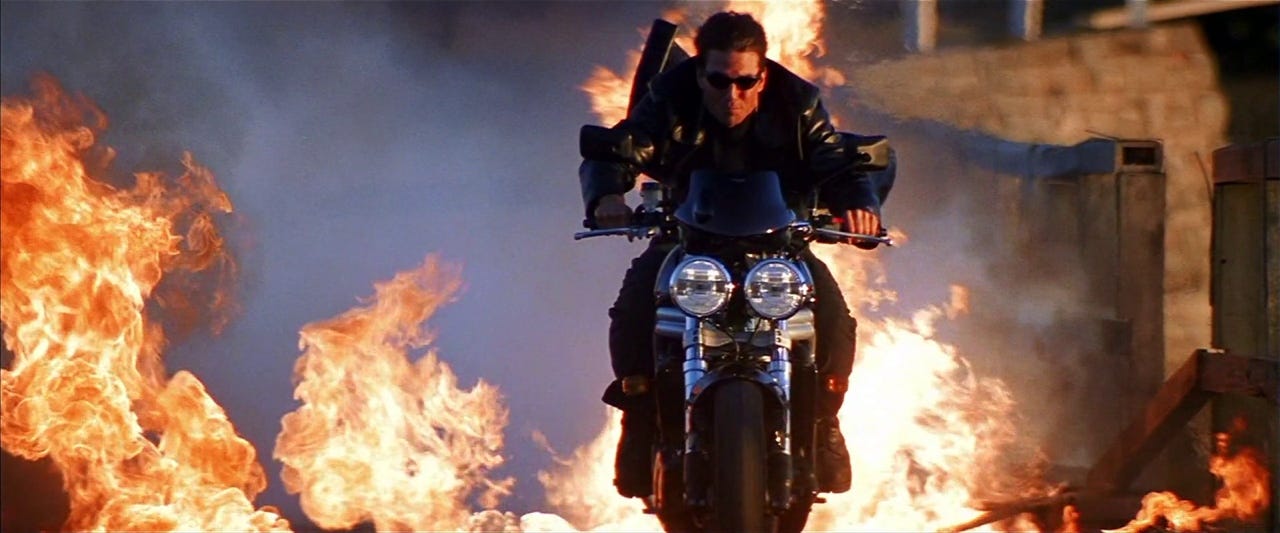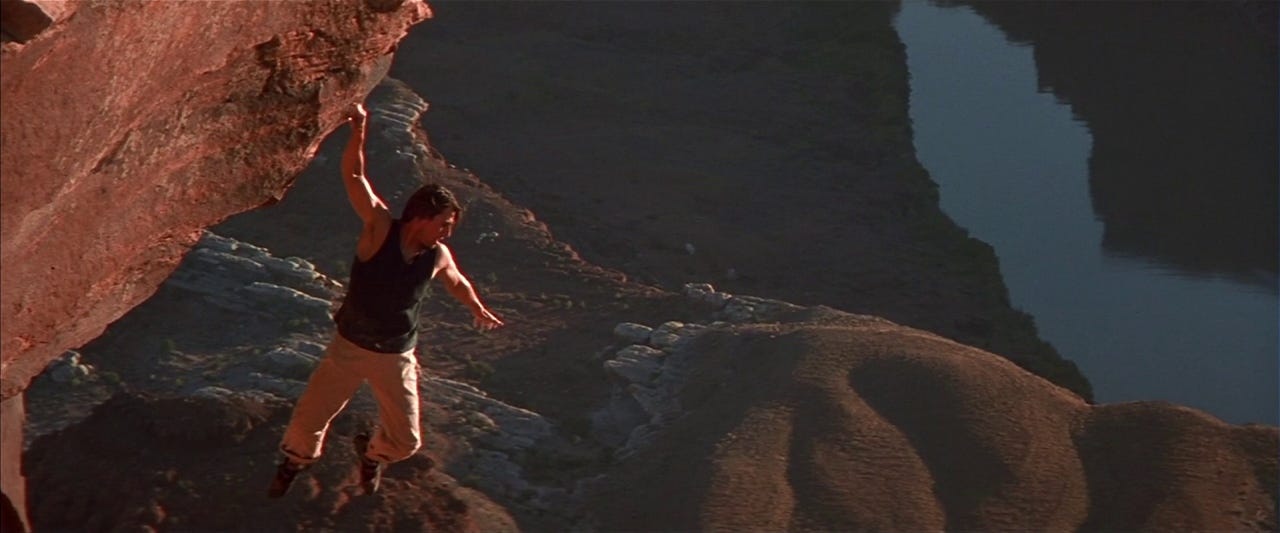Review: "MISSION: IMPOSSIBLE II" is a blissful slice of John Woo excess
In which I defend the series' most controversial entry
“We just rolled up a snowball and tossed it into hell. Now let’s see what chance it has.”
God I love this stupid movie.
Mission: Impossible II is an amazing film, one that transcends petty squabbles over ‘good’ versus ‘bad.’ It goes about as hard as it is possible for a movie to go, and is ‘extra’ in a way few movies are ever truly ‘extra.’ Watching it feels, at times, like an out-of-body fever dream, and if I am being perfectly honest, I love every second of it.
The film is genuinely hard to describe to the uninitiated, though a good starting point is “what if John Woo made a James Bond movie?” Not just any James Bond movie, mind you, but specifically one of the Pierce Brosnan entries from the 1990s. It has a similar ‘ripped from the headlines’ threat-of-the-moment (in this case bioweapons being bought and sold by big pharmaceutical companies). Dougray Scott’s character and performance are obviously modeled on Sean Bean in Goldeneye (the evil version of the hero, equally suave and skilled, but having broken bad), and the early car chase/foreplay encounter between Ethan and Nyah (Thandiwe Newton) is lifted straight from a similar scene with 007 and Famke Janssen’s Xenia Onatopp in that same film. We even get the very British Anthony Hopkins in the role of IMF chief this time around, playing a much more M-like figure than any of Ethan’s other bosses across the series.
But that overview only scratches the surface. Because Mission: Impossible II isn’t a James Bond movie. It’s barely a Mission: Impossible movie, even accepting for this franchise’s extraordinarily broad self-definition. It is, top to bottom, a John Woo movie, and so much of his utterly singular style developed in Hong Kong ‘heroic bloodshed’ actioners like A Better Tomorrow and Hard Boiled survives the journey to Hollywood fully intact: heroes and villains alike dual-wield handguns, a single white dove accompanies the hero as he walks through literal fire, set pieces are punctuated by lovingly indulgent bursts of slow-motion acrobatics, and absolutely no one, at any point in the movie, ever reloads their guns, no matter how many bullets they have fired.
The film is also John Woo doing a sort of Alfred Hitchcock pastiche, with the focused duality between Sean (Scott) and Ethan, Nyah as the ‘femme fatale’ in between them, and the strong voyeuristic overtones of Ethan watching Nyah as she spies on Sean (and vice versa, with Sean spying on Ethan through Nyah). The sheer amount of mask reveals in this one is absolutely and absurdly Freudian, and is the only Mission: Impossible movie that uses the masks to instill a fundamental instability about who we are watching at any given moment. Instead of focused bursts of twisty action or carefully crafted moments of espionage, Woo usually deploys the masks by eliding the moment where we see the characters put them on, turning Sean and Ethan into full-on shapeshifters throughout the film, tricksters whose battles often hinge on who can more thoroughly embody the other. This culminates in perhaps the most memorable scene in the movie, where Ethan swaps places with Sean’s right-hand man, Hugh Stamp (Richard Roxburgh), and tricks Sean into brutally murdering his only friend in the world. If you stop and think about it for more than a second, the scene makes precious little sense – did Ethan come to the island with masks for himself and Stamp ready to go, or did he bring the mask-making appliance with him and do it on the fly after being graced with a particularly gnarly burst of inspiration? – but it’s all pitched at this operatic scale of mythical violence, the masks coming across more like tools of mischievous gods in an ancient epic poem, such that questions of strict ‘realism’ or feasibility feel entirely out of place.
That scene is a centerpiece moment of the third act, and while there is a lot I greatly enjoy in the film up to that point – the Biotech infiltration scene in particular is pure dynamite, a clear play on the Langley heist of the first film, but where everything goes wrong and leads to a series of dramatic decisions and escalations that fundamentally reorient the film’s stakes – it is the closing stretch where Woo fully unleashes himself, and the movie reaches its delirious peak. Once Ethan arrives on the island, the film blossoms into a grand opera of heroic bloodshed, Tom Cruise stepping into the Chow Yun-fat role as Woo’s protagonist, complete with his own guardian angel dove. There are so many wonderfully unhinged images throughout the film’s climax: Ethan walking through the fire like an avenging angel; Ethan taking out multiple car-fulls of bad guys with just a motorcycle and a pistol; Ethan and Sean doing a full-on joust with their bikes and colliding in midair; Ethan kicking the gun up from the sand as he drops to the ground to get the final shot on Sean. All of it in sunglasses, of course, with Cruise’s long, wavy, positively dreamy hair whipping back and forth in the wind. Perfection.
Hans Zimmer’s score here is the most early-2000s thing you will ever hear in your life, and dates the film in a way none of the other Mission: Impossible movies are dated, but what he does at the climax of the final Sean/Ethan fight is worth specific mention: As Ethan gets into a martial arts stance – shifting his body into an entirely different kind of action language than the car- and gun-driven action of the last half hour – Zimmer drops this little gong sound, quiet at first and then reverberating across the soundscape, as all the guitars and synths go away. He then transitions into the kind of percussive beat you would hear in wuxia and Kung-fu films of the 60s and 70s, rhythmically undergirding the motions of the body and the recurring impacts of fists and feet, as Hunt finishes things in brutal-yet-graceful acrobatic fashion. It’s amazing – a great moment of synthesis where the composer perfectly follows the director as the film shifts from one kind of action language into another.
The last time I wrote about this movie, I noted how it felt emblematic of the kind of “casually virulent and dismissive” misogyny found in so many “action films of the 90s and early 00s.” I noted in particular one “horrifying bit of sexism from Anthony Hopkins' character, replying to Cruise – who insists ‘[Nyah has] no training for this kind of thing" – with ‘To go to bed with a man and lie to him? She’s a woman. She’s got all the training she needs.’” And that is, indeed, an offensive jaw-dropper of a line. But I think I sold the movie short last time in assuming the film affirms such attitudes by simply featuring them. Woo is actually pretty pointed, in that scene and others, to cut to Ethan looking visibly disgusted by what he just heard. Our hero never plays along with these attitudes, is openly hostile to the idea of putting Nyah in a ‘honeypot’ situation with Sean, and not only bristles at the use of gendered hate-language, but sees his rage towards Sean hyper-charged by the villain’s repeated use of the ‘bitch’ epithet. This is not to say the film is at all perfect in its gender dynamics – Nyah’s last real moment of agency comes when she injects herself with the virus, and she’s mostly positioned as an absent, distant object for the men to fight over in the final act – but I also appreciate how clearly the film codes Ethan’s heroism as antagonistic towards the misogyny of surrounding characters, up to and including his boss.
In fact, as weird as Mission: Impossible II frequently is, I also think the movie is underrated in all the little ways it contributes to Ethan Hunt’s characterization, particularly in how the film positions him as a ‘hero.’ The opening rock-climbing scene is a great introduction to the character, showing us that he ‘relaxes’ in his free time by almost falling to his death free-soloing – my favorite flavor of Ethan is the one with at least a couple of screws loose – and in doing so, it also gives us a preview of the kinds of bold stunt-driven storytelling that would eventually become central to the franchise starting in Ghost Protocol. And when the action of the main mission gets underway, Woo’s film continually underlines how much Ethan is defined by his refusal to accept collateral damage, his choice to infiltrate the Biotech building through an absurd stunt instead of going in guns blazing leaving him vulnerable to Sean’s machinations, and his refusal to sacrifice Nyah after she injects herself with the virus creating all the action of the third act. But as in later films, Mission: Impossible II never frames this as a weakness; as Christopher McQuarrie would zero in on in smart and moving ways in the later films, that quality is at the core of Ethan’s character – and it’s what makes his particular brand of heroism so special and relevant in our 21st-century media landscape.
Especially when that heroism is embodied by a wavy-haired man leaping through the air with two infinitely-reloading pistols and a dove flying over his shoulder.
God I love this stupid movie.
TOMORROW: We continue with J.J. Abrams’ MISSION: IMPOSSIBLE III, and I make the potentially controversial argument that it’s actually the worst film in the series.
Read the book 200 Reviews by Jonathan R. Lack in Paperback or on Kindle
Subscribe to PURELY ACADEMIC, our monthly variety podcast about movies, video games, TV, and more
Like anime? Listen to the podcast I host with Sean Chapman, JAPANIMATION STATION, where we review all sorts of anime every week. Watch on YouTube or Subscribe wherever you get your podcasts.





